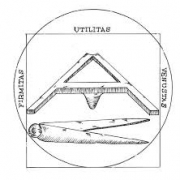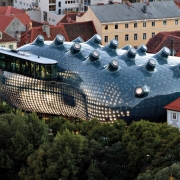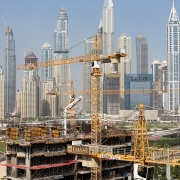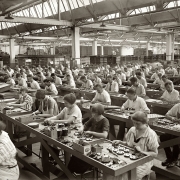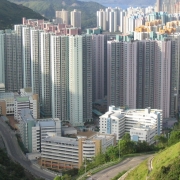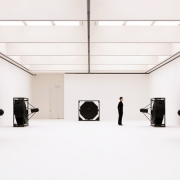STYLE
<< A particular way of literary expression, in so far as constant aspects are recognizable in it (in the way of addressing the subject, of expressing thought, in lexical, grammatical and syntactic choices, in the articulation of the period, etc.)characteristic of an era, a tradition, a literary genre, a single author […] >>
<< By extention, in the figurative arts (with use dating back to sec. 19°), the set of characters of an artist or a school (in substitution of maniera, in use since sec. 16°, and gusto, in use since sec. 18°) […] >>
Using this phrase as a definition of style, like others but I think the takeaway remains the same, it is easy to start thinking that our time has a problem with style. But from what does this absence come? Can we no longer take on the social problems of our time and try to remedy them? Or has money and private interests become stronger than any theoretical line to carry on?
If we think of contemporary architecture, that of the last twenty years I mean, it is easy to notice a remarkable disconnection between the works and the environment in which they are inserted. The world of construction in recent years has given us huge spectacular facilities, which have revolutionized our thinking and making architecture, and anonymous boxes of steel and glass that are more mere containers of activity than anything else. But it is useless to dwell too much on the description of a situation that we all know very well, insiders and not.
We are in the most flourishing and prolific period in the history of architecture, in a period that should be exciting for those who want to experiment and bring to the limit any front of our subject. Now mostly everything works. We have buildings that are safer, more efficient, more sustainable, construction processes that look towards the safety of the worker and no longer only towards the realization of the work, etc., thirty years ago all this was unimaginable.
Yet all this no longer impresses us, indeed we are almost bored, at times frightened, often displeased, in the absence of a single leitmotif that leads us unitedly in the same direction. We obtained a globalised architecture, and that frightens. But now that we can build buildings taller than the mountains and have downgraded the trilithic system to historical-artistic knowledge , making it lose the title of fundamental constructive system, we deny the results obtained and we begin to feel lost and engulfed by technological evolution and an excessive freedom of expression.
As too often happens when we are dissatisfied with the present, we turn to a past, able to come to our rescue to show us the way to take. To affirm that the present is devoid of any positivity and that we need to look elsewhere to find something worth following, admiring or living, I think is rather reductive and counterproductive when we are looking for a solution to the problem.
Our time is profoundly different from previous ages. It has different rhythms and rules. It is cosmopolitan and globalized. It is extremely accessible and, consequently, more varied in its being. Unfortunately, we have to admit that the latest technological revolution has changed the rules of our society so profoundly that we cannot speak only of an isolated problem in the architectural field. What we have today is not a limited crisis but something much bigger. It’s changed a lot in a short space of time, and we still have to recover from the hit.
The most involved aspect, from the aforementioned revolution, is the time. Although technological innovations have greatly facilitated the time necessary for the design and implementation of the project, this fact cannot be compared to the speed with which it changes our society. If then the problem of the absence of a style is a question that actually touches more areas we could conclude that it is a question that lies ahead of the only problem of belonging style. It is certainly something that affects us all and could be a social issue more than we think.
What I am saying is that perhaps before we deal specifically with the issue of style, we should take care to fully understand our time. We live in a historical moment in which the absence of a style does not compromise the work in terms of aesthetic beauty, static solidity and usefulness; consequently, the three main points of Vitruvius, to which we often refer in search of “good architecture”, wouldn’t necessarily fail.
The absence of a style, then, would not compromise the harmony with the surrounding environment, indeed, could facilitate it, if there is no situation in which it is necessary to follow the precepts with respect, a more flexible approach could be adopted which manages to adapt the project each time to a territory which is changing by its nature and which does not respond to a standardised transformation regardless of the context in which we operate.
If then the problem was the loss of a certain local “architectural typicality”, to move towards a standardization of the constructions to world level, this I think can be attributed more to the globalization than to the lack of style. It is not a recent thing that the constructions, like so many other fields, tend to standardize themselves under a single international movement.
What we are experiencing today is only the next step in a journey that began with the industrial revolution and continued with the international style. It is these revolutions and socio-economic changes that have taken place throughout history that have led us to our present; a present that it will be difficult to repudiate in favor of the past favorite epoch.
We could try to address this problem from a different perspective, trying to understand, first of all, the causes that may have led us into this situation. The lack of a “common question” in Architecture I believe is only one of the aspects that characterizes our society, which at this time is in a delicate state of transition. If the problem is global, and embraces all disciplines, then the solution should do the same and go much deeper, to the root of the problem.
From all the great revolutions that have affected man we have gained and lost something, just think of the agricultural revolution and how it has affected our physical condition. If this were true then we should look back, towards the digital revolution: to understand what we have lost and what we have gained. We could start again by asking ourselves a question perhaps which has a banal answer, even if not too much, but that surely cannot have the same answer that it has had so far, that is certain.
In 2019 do we still need a style?
Translated into English by Berk Ozturk.
– Giovanni Galli, Le maschere della forma, Carocci, 2008.
– Yuval Noah Harari,, Various Articles, www.ynharari.com, date of consultation 25/04/2019.
– Matt Alderton, Le 5 innovazioni tecnologiche che accrescono la produttività dello studio di architettura, 2018, www.autodesk.it, date of consultation 15/04/2019.
– Rem Koolhaas, Junk Space, Quodlibet, 2006, oma.eu.
– Yuval Noah Harari, J. & J. Harper, Da Animali a Dei, Bompiani, 2017, www.ynharari.com.




